| Article ID | Journal | Published Year | Pages | File Type |
|---|---|---|---|---|
| 5806110 | Veterinary Parasitology | 2011 | 4 Pages |
Human toxocariasis causes several dangerous syndromes that can involve the viscera, vision and central nervous system. Diagnosing toxocariasis requires the identification of antibodies against Toxocara canis or Toxocara cati excretions and secretions (ES). To obtain ES it is necessary to collect a large number of larvae. However, since the earliest work describing the culture of Toxocara larvae, few advances in the method have been made. It has been suggested that carbon dioxide triggers molecular mechanisms that enable nematode hatching. A similar hypothesis has been made regarding Giardia excystation. To test the hypothesis we used the Giardia excystation HBSS method to hatch embryonated T. canis eggs. We found that the HBSS method was more effective than the original De Savigny method. Our results suggest that both parasites require stimulation in an acidic environment, and the abrupt change to a basic milieu in duodenum. This physiological adaptation is successful to exploit the intestinal habitat.
